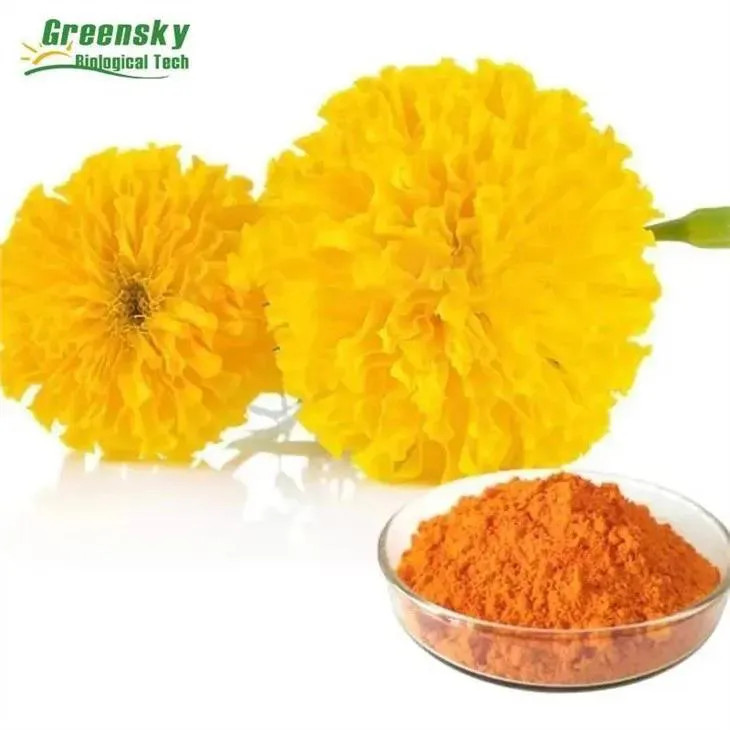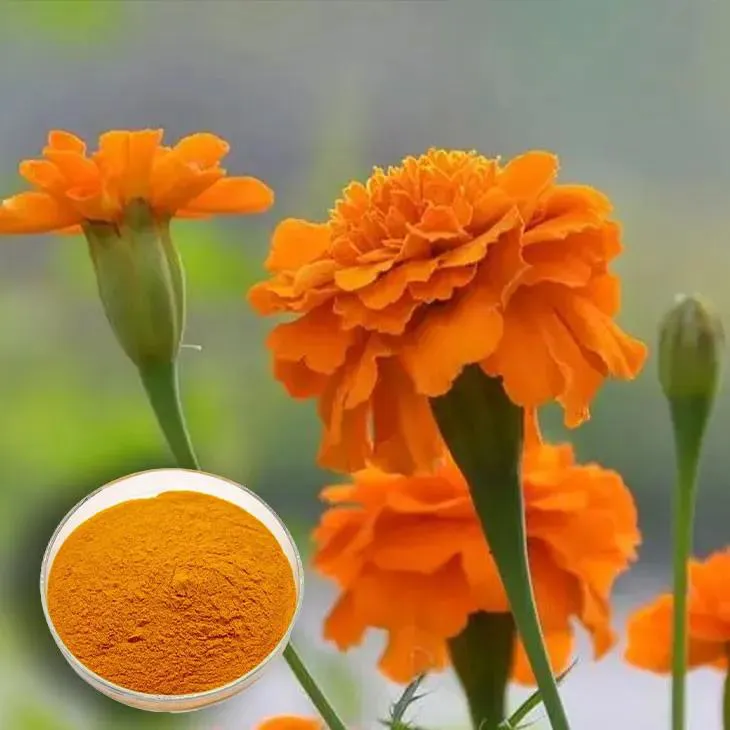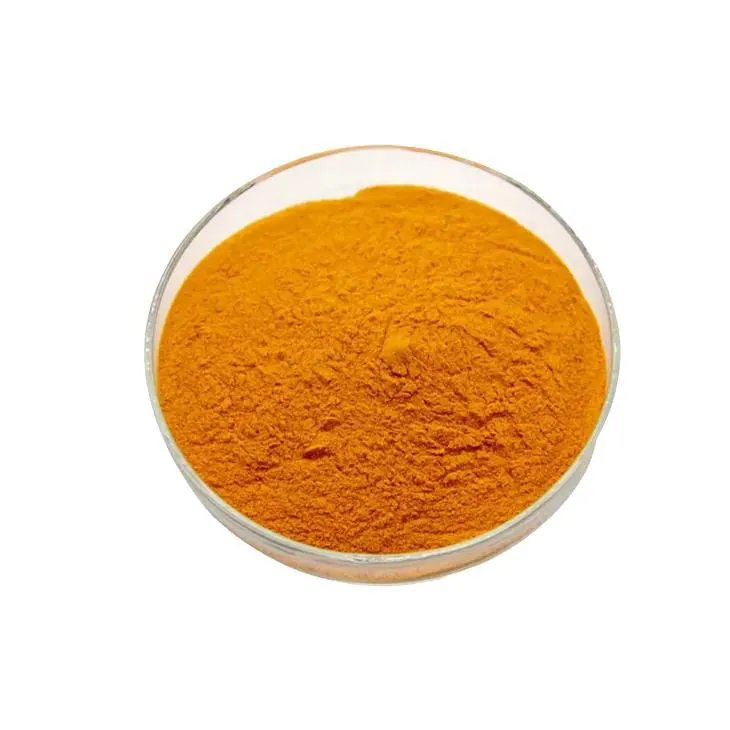- 0086-571-85302990
- sales@greenskybio.com
How to extract marigold extract from plants?
2024-11-29

1. Introduction to Marigold and Its Extract
Marigold, a well - known plant, is rich in various compounds that make its extract highly valuable. Marigold Extract has found extensive applications in multiple industries, such as cosmetics, pharmaceuticals, and food. The main active components in marigold include flavonoids, carotenoids, and triterpenoids. These components contribute to the antioxidant, anti - inflammatory, and antimicrobial properties of the extract.

2. Harvesting Marigold for Extraction
2.1. Optimal Time for Harvesting
The time of harvesting marigold is crucial for obtaining high - quality extract. Generally, marigolds are harvested when they are in full bloom. At this stage, the content of active components in the plant is relatively high. For most marigold varieties, this is usually during the summer or early fall. Harvesting too early may result in lower yields of active components, while harvesting too late may lead to the degradation of some components.2.2. Harvesting Methods
There are several methods for harvesting marigolds. Manual harvesting is a common approach, especially for small - scale production or in cases where precision is required. Workers carefully pick the flower heads, leaving the stems and leaves behind. This method ensures that only the parts with the highest concentration of active components are collected. In large - scale commercial production, mechanical harvesting may be employed. However, mechanical harvesting needs to be carefully designed to minimize damage to the flower heads and to avoid contamination.
3. Pretreatment of Marigold before Extraction
3.1. Cleaning
After harvesting, the marigold flower heads need to be thoroughly cleaned. This step is essential to remove dirt, debris, and any potential contaminants. Clean water is used for washing, and gentle agitation can help to dislodge any adhered particles. It is important to ensure that the cleaning process does not cause damage to the flower heads or lead to the loss of active components.3.2. Drying
Drying is another important pretreatment step. There are different drying methods available. Air drying is a traditional method, where the marigold flower heads are spread out in a well - ventilated area. However, this method may be time - consuming. Another option is using a drying oven at a low temperature. A temperature range of 40 - 50°C is often suitable for drying marigold without significant degradation of active components. Drying helps to reduce the moisture content of the flower heads, which is beneficial for the subsequent extraction process.
4. Extraction Methods
4.1. Solvent Extraction
- Solvent selection: Different solvents can be used for Marigold Extraction. Commonly used solvents include ethanol, hexane, and ethyl acetate. Ethanol is a popular choice as it is relatively safe, cost - effective, and can extract a wide range of components. Hexane is mainly used for extracting lipophilic components such as carotenoids. However, hexane is flammable and requires proper safety precautions.
- Extraction process: In solvent extraction, the dried marigold flower heads are usually ground into a powder to increase the surface area. Then, the powder is mixed with the selected solvent in a suitable ratio. A typical ratio could be 1:5 - 1:10 (marigold powder: solvent) depending on the extraction efficiency desired. The mixture is then stirred or shaken for a certain period, usually several hours to overnight. After that, the extract is separated from the solid residue through filtration or centrifugation.
4.2. Supercritical Fluid Extraction
- Principle: Supercritical fluid extraction (SFE) is a more advanced extraction method. Supercritical fluids have properties between those of a liquid and a gas. Carbon dioxide (CO₂) is the most commonly used supercritical fluid for Marigold Extraction. At supercritical conditions (above its critical temperature of 31.1°C and critical pressure of 73.8 bar), CO₂ has high diffusivity and low viscosity, which enables it to penetrate the plant material effectively and extract the desired components.
- Extraction process: In SFE, dried marigold is placed in an extraction vessel. Supercritical CO₂ is then pumped into the vessel. The extraction is carried out at a specific temperature and pressure, which are carefully controlled to optimize the extraction of different components. After extraction, the pressure is reduced, and the CO₂ returns to a gaseous state, leaving the marigold extract behind. SFE has several advantages, such as being a "green" extraction method as CO₂ is non - toxic and non - flammable, and it can produce extracts with high purity and better quality compared to solvent extraction.
4.3. Microwave - Assisted Extraction
- Mechanism: Microwave - assisted extraction (MAE) utilizes microwave energy to heat the marigold - solvent mixture. The microwaves cause the polar molecules in the solvent to rotate rapidly, generating heat internally. This internal heating results in more efficient extraction as it disrupts the cell walls of the marigold more effectively, allowing the active components to be released more easily.
- Procedure: The marigold sample is combined with the solvent in a microwave - compatible container. The mixture is then exposed to microwave radiation for a specific time and at a specific power level. The extraction time and power need to be optimized depending on the type of marigold and the solvent used. After microwave treatment, the extract is separated from the sample using the same methods as in solvent extraction, such as filtration or centrifugation.

5. Post - Extraction Processing
5.1. Concentration
The marigold extract obtained from the extraction process may have a relatively low concentration of active components. Concentration is often required to increase the potency of the extract. This can be achieved through methods such as rotary evaporation. In rotary evaporation, the extract is placed in a round - bottomed flask and heated under reduced pressure. The solvent is evaporated, leaving behind a more concentrated marigold extract.5.2. Purification
Purification is an important step to remove impurities from the marigold extract. Chromatographic techniques can be used for purification. For example, column chromatography can separate different components based on their affinity for the stationary and mobile phases. By using an appropriate stationary phase (such as silica gel) and mobile phase (such as a solvent mixture), impurities can be separated from the desired marigold components.6. Analysis and Standardization of Marigold Extract
6.1. Analysis Methods
- High - Performance Liquid Chromatography (HPLC): HPLC is a powerful analytical tool for marigold extract. It can separate and quantify the different components in the extract. By using a suitable column and mobile phase, flavonoids, carotenoids, and other components can be accurately analyzed.
- Spectrophotometry: Spectrophotometry can be used to measure the total content of certain components in the marigold extract. For example, the total carotenoid content can be determined by measuring the absorbance at a specific wavelength. This method is relatively simple and fast, but it may not provide detailed information about individual components like HPLC.
6.2. Standardization
Standardization of marigold extract is necessary to ensure its quality and consistency for different applications. The content of key active components, such as lutein (a major carotenoid in marigold), is often used as a standardization parameter. Manufacturers need to ensure that their marigold extracts meet the specified standards in terms of component content, purity, and other quality attributes. This is crucial for applications in cosmetics, pharmaceuticals, and food industries, where strict quality control is required.7. Storage of Marigold Extract
Proper storage of marigold extract is essential to maintain its quality. The extract should be stored in a cool, dry, and dark place to prevent degradation of the active components. Amber - colored glass containers are often preferred as they can block light. In addition, the storage containers should be airtight to prevent oxidation. If stored under optimal conditions, marigold extract can maintain its quality for an extended period, allowing for its use in various applications over time.
FAQ:
What are the main components in marigold relevant to extraction?
Marigold contains components such as flavonoids, carotenoids (especially lutein and zeaxanthin), and some essential oils. These components are important targets during the extraction process as they contribute to the various properties and potential applications of the marigold extract in fields like cosmetics and pharmaceuticals.
What are the advantages of supercritical fluid extraction for marigold?
Supercritical fluid extraction has several advantages. Firstly, it can operate at relatively low temperatures, which helps to preserve the thermally - sensitive components in marigold. Secondly, it often provides a higher yield compared to some traditional extraction methods. Thirdly, the selectivity of supercritical fluids can be adjusted, allowing for more targeted extraction of specific components in marigold, resulting in a higher - quality extract.
How to ensure the quality of marigold extract during post - extraction?
During post - extraction, quality can be ensured through several methods. One is to conduct proper purification steps to remove impurities. Analyzing the extract for its active component content, such as using chromatography techniques to determine the levels of flavonoids or carotenoids. Additionally, storing the extract under appropriate conditions, such as in a cool, dry, and dark place, can also help maintain its quality over time.
What are the applications of marigold extract in the pharmaceutical industry?
Marigold extract has various applications in the pharmaceutical industry. Its antioxidant properties, due to components like flavonoids and carotenoids, can be used to prevent oxidative stress - related diseases. It may also have anti - inflammatory effects, which can be beneficial in treating inflammatory conditions. Some studies suggest that certain components in marigold extract could have potential in anti - cancer research, although more research is needed in this area.
What are the challenges in extracting marigold extract?
One challenge is the selection of the appropriate extraction method. Different extraction methods may vary in efficiency and cost. Another challenge is to ensure the stability of the extracted components, especially those that are sensitive to environmental factors such as light and heat. Additionally, standardizing the extraction process to produce consistent quality of the extract across different batches can also be a difficult task.
Related literature
- Extraction and Characterization of Bioactive Compounds from Marigold (Tagetes erecta L.)"
- "Supercritical Fluid Extraction of Marigold (Tagetes spp.) for Lutein and Zeaxanthin: A Review"
- "Marigold Extract in Cosmetics: Properties and Applications"
- ▶ Hesperidin
- ▶ citrus bioflavonoids
- ▶ plant extract
- ▶ lycopene
- ▶ Diosmin
- ▶ Grape seed extract
- ▶ Sea buckthorn Juice Powder
- ▶ Beetroot powder
- ▶ Hops Extract
- ▶ Artichoke Extract
- ▶ Reishi mushroom extract
- ▶ Astaxanthin
- ▶ Green Tea Extract
- ▶ Curcumin Extract
- ▶ Horse Chestnut Extract
- ▶ Other Problems
- ▶ Boswellia Serrata Extract
- ▶ Resveratrol Extract
- ▶ Marigold Extract
- ▶ Grape Leaf Extract
- ▶ blog3
- ▶ blog4
-
The best yohimbe bark extract on the market.
2024-11-29
-
Standard - process Mulberry Leaf Extract.
2024-11-29
-
100% Pure Natural White Willow Bark Extract.
2024-11-29
-
The Best Method for Extracting Vitamin D3.
2024-11-29
-
Chinese Lycopene Powder Factories.
2024-11-29
-
Green coffee bean Extract
2024-11-29
-
Aminolevulinic acid
2024-11-29
-
Dandelion Leaf Extract
2024-11-29
-
Phellodendron Extract
2024-11-29
-
Berberis aristata Extract
2024-11-29
-
Artichoke Leaf Extract
2024-11-29
-
Rose Hip Extract
2024-11-29
-
Curcumin
2024-11-29
-
Ivy Extract
2024-11-29
-
Lavender Extract
2024-11-29





















